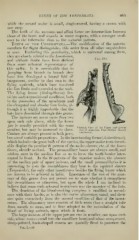Page 455 - My FlipBook
P. 455
TEETH OF THE VERTEBRATA. 465
while the second molar i.s small, single-rooted, having a crown with
one cusp.
The teeth of the raccoons and allied forms are intermediate between
those of the bears and weasels in many respects, with a stronger tend-
ency to the tubercular than to the sectorial pattern.
Teeth of the Cheiroptera,—The modification of the anterior
members for flight distinguishes this order from all other unguiculates
at once. Excluding this peculiarity, which is univ^ersal among them,
they are closely related to the Insectivora,
Fig. 244.
and without doubt have been derived
from some arboreal representative of
this order. It is conceivable that in
jumping from branch to branch they
have first developed a lateral fold of
integument, similar to that seen in the
flying squirrels, which later involved
the fore limbs and extended to the neck.
The flying lemur (^(jr(deopitJu'cn.s) fur-
nishes such a transitional condition, both
in the possession of the membrane and
the elongated and slender fore limbs, al-
though it is highly improbable that the
bats have descended through this genus.
The incisors are never more than two
upon each side above, while the lower
jaw is usually provided wath the same
Vertical View of the Upper and I^ower
number, but may be increased to three. Jaw of American Pine Marten (Mustela
umericana).
Canines are always present in both jaws,
but are of variable proportions. In the insect-eating forms (Animalivora),
which includes the great bulk of the species, the upper molar teeth invari-
ably display the peculiar W-pattern of the moles, shrews, etc, of the Insec-
tivora, already noticed. The premaxillary bones are always small, and
seldom meet in the median line so as to leave the tooth-border inter-
rupted in front. In the W-pattern of the superior molars, the absence
of the median pair of upper incisors, and the small premaxillaries it is
interesting to note the resemblances they bear to the squirrel shrews
[Taiipaiada'), the only other insectivores besides the flying lemur which
are known to be arboreal in habit. Ignorance of the rest of the anat-
omy of this genus does not permit me to state whether it strengthens
this resemblance or otherwise, but upon the whole I am inclined to
believe that some such arboreal insectivore was the ancestor of the bats.
The dentition of the l)lood-sucking vampires is modified in accord-
ance with their habits, as is also the entire alimentary canal, and devi-
ates quite extensively from the normal condition of that of the insect-
eaters. The alimentary tract consists of little more than a straight tube
from mouth to anus, and is thus adapted to the assimilation of the
blood of living animals, upon which it feeds.
The large incisors of the upper jaw are two in number, one upon each
side, whose roots extend into the maxillary bone, and whose compressed,
sharp-pointed, hook-shaped crowns are specially fitted to puncture the
Vol. I.—30


